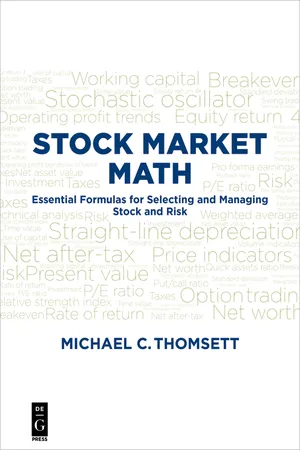
Stock Market Math
Michael C. Thomsett
- 283 pages
- English
- ePUB (mobile friendly)
- Available on iOS & Android
Stock Market Math
Michael C. Thomsett
About This Book
Stock Market Math shows you how to calculate return, leverage, risk, fundamental and technical analysis problems, price, volume, momentum and moving averages, including over 125 formulas and Excel programs for each, enabling readers to simply plug formulas into a spread sheet.
This book is the definitive reference for all investors and traders. It introduces the many formulas and legends every investor needs, and explains their application through examples and narrative discussions providing the Excel spreadsheet programs for each. Readers can find instant answers to every calculation required to pick the best trades for your portfolio, quantify risk, evaluate leverage, and utilize the best technical indicators.
Michael C. Thomsett is a market expert, author, speaker and coach. His many books include Mathematics of Options, Real Estate Investor's Pocket Calculator, and A Technical Approach to Trend Analysis. In Stock Market Math, the author advances the science of risk management and stock evaluation with more than 50 endnotes, 50 figures and tables, and a practical but thoughtful exploration of how investors and traders may best quantify their portfolio decisions.
Frequently asked questions
Information
Chapter 1
Rates of Return on Investment:
What Goes In, What Comes Out
Judging the Outcome – What Did You Expect?
- The purchase price is the assumed “starting point.” It is easy to fall into the trap of believing that the point of entry to any investment is the price-based starting point. Thus, the assumption is that price must move upward from that point. No consideration is given to the realistic point of view that price at any given moment is part of a continuum of ever-evolving upward and downward price point movements. As a starting point, price does not always move upward. In other words, profitability is not the only possible outcome; the rate of return may also be negative.
- A bail-out and/or profit goal is not specifically set. Too often, an investment is made with little or no idea about the individual’s expectations. Do you plan to double your money? Triple it? Or would you settle for a 15% return in one year? Equally important is the question of possible loss. How much of your investment capital will you lose before you cut your losses and close it out? If you don’t set goals and identify the point at which you will close the investment, then you cannot know what to expect.
- The specific method of calculation is not understood. It is difficult to determine whether an investment is a success of a failure unless you also know how the return calculation is made. This includes making clear distinctions between different types of returns, the effect of taxes, and how the formula works. All of these variables have to be considered with consistent comparisons between them or they will not be valid.
- The time factor is not considered. You need to take into account the reality that not all investments produce a return in the same amount of time. The longer the time required (thus, the longer your capital is tied up), the less effective the return. So, the time element is crucial to the comparison of one investment to another.
- The varying degrees of risk are not taken into account. Risk is not only as aspect of opportunity; it is really the reverse effect of it as well. Opportunity for profit and risk of loss are two sides of the same coin. This relationship between the two attributes is shown in Figure 1.1.

The Basic Equation: Return on Cash Invested
Table of contents
- Cover
- Title Page
- Copyright
- Contents
- Chapter 1: Rates of Return on Investment: What Goes In, What Comes Out
- Chapter 2: Returns on Capital: Putting Cash to Work
- Chapter 3: Leverage and Risk Analysis: Maximizing Other People’s Money
- Chapter 4: Long-Term Trends: Patience Rewarded
- Chapter 5: Core Earnings and Net Worth Adjustments: Making the Numbers Real
- Chapter 6: Fundamentals: Balance Sheet Tests You Need to Know
- Chapter 7: Fundamentals: Operating Statement Tests You Need to Know
- Chapter 8: Market Trend Calculations
- Chapter 9: Price Indicators
- Chapter 10: Volume Indicators
- Chapter 11: Momentum Oscillators and Moving Averages
- Chapter 12: Combined Testing: Merging Price and Financial Tests
- Appendix B: Excel Program Entries: Automating the Formulas
- Index